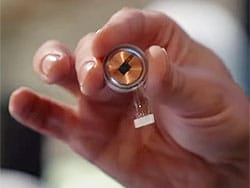Billionaire Elon Musk's neurotechnology start-up company Neuralink is making headway in developing what it describes as a transformational implantable brain-machine interface (BMI) that will stimulate the brain, allowing paralyzed patients to move, blind patients to see, and deaf patients to hear.

The Neuralink transformational implantable brain-machine interface. Nuralink
Musk also claims the device will revolutionize the treatment of a host of neurologic conditions.
In a recent live online update, Musk demonstrated a "working" device in a pig, including the firing of neurons in real time. He also announced that the company has received breakthrough device designation from the US Food and Drug Administration (FDA).
The first in-human clinical study of the device will involve patients who have quadriplegia as the result of a spinal cord injury. However, Musk said it's unclear exactly when the trial will get underway, because regulatory and safety testing requirements still need to be addressed.
BMIs connect computers and smartphones to the brain where neurons communicate via electrical impulses, also known as neuronal spikes.
A small robot inserts flexible, electrode-containing "threads" that are thinner than a human hair into the cortex. The robot is reportedly capable of inserting six threads, or 192 electrodes, per minute.
The electrodes are made of materials designed to last for decades, if not longer, which is important, said Musk, because the brain is a "corrosive" environment. The challenge, he said, is to create "an insulating layer that is very robust but also very thin."
A "Fitbit in Your Skull"
The tiny wires are connected to a coin-sized device (measuring about 23 mm by 8 mm) that replaces a piece of the cranium. Musk described the device as a "Fitbit in your skull." The device can be hidden under the hair so that a person's appearance is "completely normal," he said.
The current version of the device has about 1024 channels, each of which is capable of recording and stimulating neurons from multiple layers within the cortex. Full bandwidth data will stream from the device, and recordings will come from all channels simultaneously.
Patients will use an iPhone app that communicates via Bluetooth to the implanted device. The Neuralink device has an "all-day battery life" and can be charged overnight in the same way as a smartwatch or iPhone. It's "completely seamless" with no wires, said Musk.
Implanting the device does not entail major surgery. Musk compared it to a simple and safe LASIK eye procedure and noted that it can be performed without general anesthesia.
The Neuralink brain stimulation system, said Musk, "is about 100 times better than the next best consumer device that's available."
Current brain stimulation technologies include devices that provide neurostimulation for epilepsy patients and deep brain stimulation for patients with Parkinson's disease (PD). However, these technologies are limited. For example, the FDA-approved system used for PD has only about 10 electrodes.
Eventually, a robot will perform all related procedures, said Musk. These will include removing the small piece of skull, inserting electrodes, replacing the skull piece with the device, and sealing it.
Unlimited Potential?
The initial focus will be to help patients with a spinal cord injury regain movement. The first clinical trial will enroll "a small number of patients" with paraplegia or tetraplegia "to make sure the device is safe and that it works," said Matthew MacDougall, MD, Neuralink's head neurosurgeon.
"I'm confident that, long term, it will be possible to restore somebody's full body motion, so even if they have a severed spine, they will be able to walk again, they will be able to use their hands," added Musk.
Patients with a severed spine "essentially have broken wires." The idea is to "jump over those wires and transfer the signals over those wires," he said.
The technology will have the capability of treating a range of brain-related conditions and disorders, said Musk. He noted that over time, most people will develop a neurologic problem.
Although at first, electrodes will be inserted only in surface layers of the cortex, the company plans to modify the device and to use longer electrodes to access deeper areas of the brain.
There seems to be no limit to the potential of the technology. Ultimately, said Musk, there is no reason why, at least in principle, the system can't eventually replace speech, so instead of talking with words, people will simply exchange thoughts. Musk referred to this as "conceptual telepathy."
Another potential development down the road will be what Musk calls "fully immersive video games."
The ultimate goal is to have a full brain-machine interface, which means achieving "some kind of symbiosis with AI [artificial intelligence]," said Musk.
"It's going to be important to figure out how we coexist with advanced AI," he added.
He acknowledged that developing the technology is a slow process and that FDA approval could take some time. Aside from the logistics, a host of ethical, legal, and social issues, as well as concerns regarding privacy, will likely need to be addressed before human brains are routinely linked to computers
Musk said that, having secured a breakthrough device designation, the company is working closely with the FDA. "We will significantly exceed the minimum FDA guidelines for safety," he said.
Musk acknowledged that the procedure to implant the system will initially be "quite expensive" but that the cost would rapidly drop.
"We want to get the price down to something like a few thousand dollars," he said.
For more Medscape Neurology news, join us on Facebook and Twitter.
Medscape Medical News © 2020
Cite this: Elon Musk Updates Status of Neuralink's Brain-Machine Interface - Medscape - Aug 31, 2020.








Comments